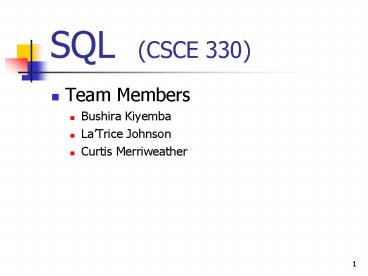SQL (CSCE 330) - PowerPoint PPT Presentation
Title:
SQL (CSCE 330)
Description:
Designed by IBM research center in 1974-1975 ... INSERT INTO STATION VALUES (66, 'Caribou', 'ME', 47, 68); 14. Selection Statement. 68 ... – PowerPoint PPT presentation
Number of Views:31
Avg rating:3.0/5.0
Title: SQL (CSCE 330)
1
SQL (CSCE 330)
- Team Members
- Bushira Kiyemba
- LaTrice Johnson
- Curtis Merriweather
2
SQL Origins
- Relational Model formally defined by
- Dr. E.F. Codd in 1970s, reflects SQLs
conceptual core - A Relational Model of Data for Large Shared Data
Banks
3
SQL Origins
- Designed by IBM research center in 1974-1975
- System/R project, prototype of a relational
database - Originated as SEQUEL, structured English Query
Language, hence the pronunciation of SQL
4
SQL Origins
- 1979, commercial relational database management
system Oracle, used SQL as its query language - ANSI approved SQL as official standard in 1986,
ISO standardized in 1987
5
Database Concepts
- A database is a software program which allows for
storage and retrieval of information on a
computer hard drives file system or other
device. A relational database is a database that
allows for queries which typically use Structured
Query Language (SQL) to store and retrieve data.
6
Database Concepts
- Relational databases allow for more efficient
queries which use less CPU power and memory
allocation, as they are optimized for efficiency.
However, connecting to a database is
significantly slower than just reading a simple
file off of your computers hard drive. The added
features of a relational database make this speed
decrease worthwhile in many situations.
7
Database Concepts
- One of the most popular databases used for
dynamic web database applications is called
mySQL. It is commonly installed on popular web
hosting providers Unix and Linux servers.
8
Database Concepts
- Data in relational databases is stored in four
primary areas databases, tables, rows, and
columns. A database is an area within the
database software that contains all the tables
that make up this particular set of data.
9
SQL Column Data Types
- Auto Increment ID Fields
- Varchar
- Char
- Integer
- Blob
- Bit
10
Additional SQL Commands
- Show - Show can be used to show all database
tables in a particular database, or all databases
in a particular server. - Describe - Describe lets you see the structure of
an existing database table - Insert - Insert is how you input information into
the database. - Update - Update lets us update values inside an
existing row inside a table.
11
Additional SQL Commands
- Delete - Delete lets us delete rows inside a
table. - Select - Does queries on the database to extract
data from it.
12
Table Creation
- CREATE TABLE STATION (ID INTEGER PRIMARY KEY,
CITY CHAR(20), STATE CHAR(2), LAT_N REAL,
LONG_W REAL)
13
Table Population
- INSERT INTO STATION VALUES (13, 'Phoenix', 'AZ',
33, 112) INSERT INTO STATION VALUES (44,
'Denver', 'CO', 40, 105) INSERT INTO STATION
VALUES (66, 'Caribou', 'ME', 47, 68)
14
Selection Statement
SELECT FROM STATION
ID CITY STATE LAT_N LONG_W
13 Phoenix AZ 33 112
44 Denver CO 40 105
66 Caribou ME 47 68
15
SQL and other Languages
- There are three main means for integrating SQL
into a - language
- Direct
- Embedded support like Powerbuilder
- Indirect embedded support through a
pre-processor - Database API support
- Examples
- SQL and Python
- SQL and Perl
16
Embedding SQL in Python
- SELECT name INTO my_name
- FROM segments
- WHERE segment my_segment
17
Embedding SQL in Perl
- lt?PERLgt
- my _at_data
- lt?SQL SQL"select name, address,
- from people
- where name like '' ? ''"
PARAMS"search_name" - MY VAR"n, a, p"gt
- push _at_data,
- name gt n, address gt a, phone gt p,
- lt?/SQLgt
- use DataDumper
- print Dumper (\_at_data)
- lt?/PERLgt
18
Conclusion
- The Structured Query Language (SQL) forms the
backbone of most modern database systems. It
operates on sets of data rather than one data
element at a time. With a single statement, you
can get just exactly the answer you wanted from
gigabytes of data in a millisecond. - SQL is not particularly expressive and hence
the need for procedural languages and other
proprietary extensions
19
Sources
- http//www.itworld.com/nl/db_mgr/05142001/
- http//networking.webopedia.com/TERM/S/SQL.html
- http//www.opengroup.org/public/tech/datam/sql.h
tm - http//databases.about.com/cs/sql/?oncetrue
- http//www.paragoncorporation.com/ArticleDetail.
aspx?ArticleID6 - http//www.geocrawler.com/archives/3/184/2000/12
/0/4789047 - http//www.python.org/search/hypermail/python-re
cent/0551.html - http//www.itl.nist.gov/div897/ctg/dm/sql_exampl
es.htmlcreate20table - http//www.expertwebinstalls.com/cgi_tutorial/ba
sic_relational_database_concept.html - http//developer.mimer.com/documentation/html_82
/Mimer_SQL_Reference_Manual - l































